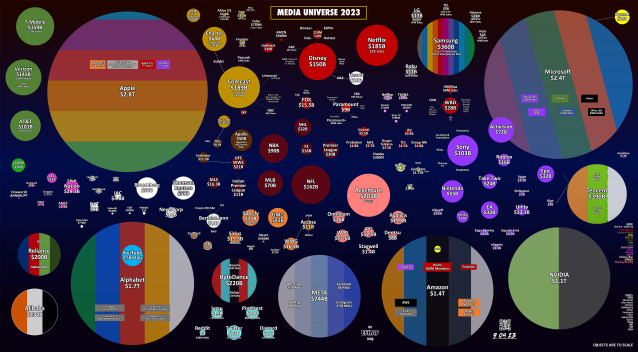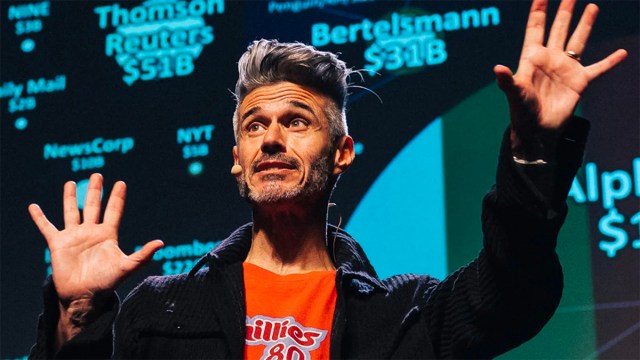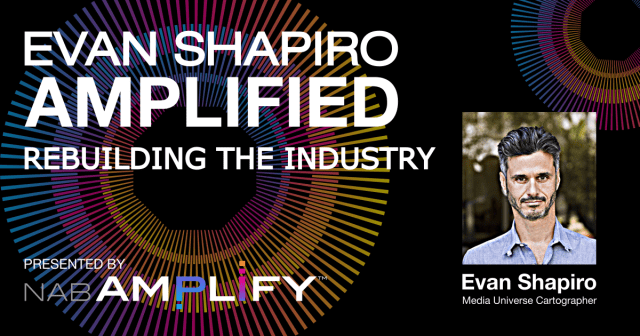
TL;DR
- Evan Shapiro has debuted a new kind of media map: the Global Media Ecosystem, which illustrates where both audiences and economies are gravitating, rather than only focusing on the market cap of individual companies.
- Spoiler alert: mobile video and gaming have really come into their own, and media companies need to start integrating this type of content into their portfolio to most effectively leverage their IP.
- Shapiro offers seven suggestions for thriving in the year 2023. All require an understanding of the current landscape and changing tastes of younger demographics and emerging markets. Still, his way forward sounds remarkably common sense.

Evan Shapiro’s latest map of the media universe has a new look. (And if you think that the resemblance to old-school video games is coincidental, you’re fooling yourself.)
Shapiro’s map of the 2023 Global Media Ecosystem is scaled according to the size of communities. This newly retooled version reflects a different way of thinking.
Per Shapiro, this version “refocuses our view around the audiences and economics at the foundation of our Global Media Ecosystem.”
In Amsterdam, Shapiro told an IBC audience, “This map is meant to be specifically a graphical representation of how most media consumers across the planet look at our media ecosystem right now.”
What’s New and Notable?
What can we learn from Shapiro’s latest map (crafted from Ampere Analytics data)?
Vive le mobile révolution! About half of all mobile usage (cellular data, not time) consists of video, and half of all video content watched on mobile is YouTube, reports Michael Burns for IBC365.
Additionally, the gaming sector is not just fun and games. Brands are now raking in $94 billion worth of in-game revenue annually. Burns notes that this is more than AVOD and FAST advertising represents. (Also, this is probably why the new map looks the way it does. Only Evan can confirm or deny.)
So who’s playing their cards right? Shapiro says Sony, the New York Times, and Amazon are all making smart bets and diversifying their portfolio in ways that anticipated where the market’s headed.
He told Burns, “Sony plays across that ecosystem incredibly well,”
he said. “They’re in gaming. They’re in TV. They have a huge audio business. They have one of the best niche subscriber products in the world in Crunchyroll and Funimation. They’re in hardware that touches all of these things. It’s a multifaceted company.”
Some may be surprised he counts NYT as a winner, but Shapiro points out that this legacy media company “has a strategy for this entire map. It does gaming, social, audio, news, cooking and sports and all these different things. It’s a model for transformation for
traditional media in this new age.” Shapiro thinks its “digital content bundle” even comes close to rivaling Amazon!
Speaking of which. He notes, Amazon’s Prime Video will host “a live shopping event at the halftime of the Jets-Dolphins game on Black Friday in the United States.”
He told IBC attendees, “Both (the New York Times and Amazon] are right now multifaceted, personalized lifestyle bundles that power a constant state of evolution around the needs of their customers. Two very different companies; one that inspired the new era that we’ve already begun, and the other that had to reinvent itself to compete ably inside this era.”
On the big tech side, Shapiro shouts out Apple and Google: “
Apple helped drive us to this moment and to this user centric era. And they are beyond well armed to battle for their place atop it with an arsenal of media services that goes along with their best in breed tech. Google starts this new era in pole positions across every segment of the media economy, video, social, audio and gaming. These and other tech giants are readying themselves to use their enormous resources to battle for control of the hearts and the minds and the money represented on this map. But they cannot and they will not run this ecosystem by themselves.”
Oh, and about YouTube? Shapiro says Google’s video platform relies on traditional media to survive. He tells Burns, “Without the Public Service Broadcasters and the local content creators, YouTube would be a wasteland, no one would ever go there. Yes, it has to have MrBeast, but it also has to have local creators and news. Increasingly that’s where people are going. YouTube is the biggest channel on television, in the UK, in Italy, and Germany. Why? Because you can get stuff from all around the world but also you can get news from around the corner.”
How can companies wrap their head around all this change? Shapiro suggests, “The fastest way to get there is [diversifying] age and class and race and gender. But you can find old white dudes like Mark Thompson (ex-BBC DG, ex-New York Times CEO, and now CEO of CNN) who think differently, you just have to know where to look for them.”
READ MORE: Interview: Evan Shapiro – Charting Disruption With Graphic Content (IBC365)
Your Favorite Map Is Here ⬇️
If you’re attached to the old look (and focus), never fear: Shapiro also made the 55th (!) update to his original media map (below).

Click here to view/download a large version.
Just keep in mind that Shapiro would likely chide you, sharply, if you don’t take a closer look at the Global Media Ecosystem (September 2023) graphic, too.
That’s because he knows that people tend to view these maps as predictive, but they’re actually made in real time. As he told his Substack subscribers, “This map is not a warning. It’s a weather report.”
“Everything that’s happened in the media ecosystem [since 2020] has only proved the thesis that much more,” Shapiro told attendees at his IBC2023 keynote.
Surviving the Media Apocalypse
Shapiro insists that he’s an optimist (repeatedly) and even offers a survival kit for media companies that want to thrive in this era of change.
There are seven ingredients Shapiro thinks we need to succeed in 2023 and beyond:
- Understand that IP is the hub of the wheel, which means that video, audio, social, and gaming are all spokes and not separate categories any more.
- You don’t have to choose between subscription-based or ad-based models anymore.
- Look outside of North America if you want to grow your footprint. Africa in particular has a lot of potential for investment.
- You need Silicon Valley, and Silicon Valley needs your content.
- Create and maintain relationships with your audience, and don’t let another company be the gatekeeper.
- Consumers are buying content, which makes it a product. Invest in something worth paying for.
- New ideas require new kinds of people, and you need to understand the users you hope to gain and retain. That means sourcing leaders who don’t think and look and act like you.



